Hot Limewashes and Sheltercoats
Nigel Copsey
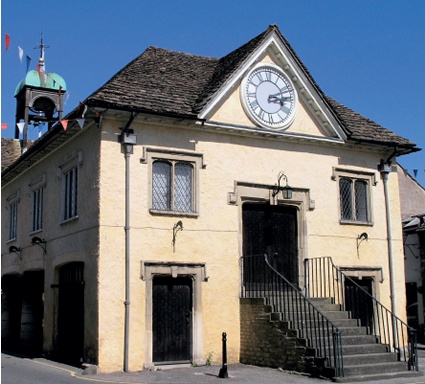 |
|
| Traditional thick limewash on Tetbury Town Hall |
The revival in the use of hot-mixed lime mortars has been gathering pace across the UK and Ireland over the past three years, and the use of quicklimes in conservation and repair is now becoming increasingly routine. This has injected new energy and insight into the wider lime revival, affecting not just construction mortars but also decorative finishes and surface treatments.
As craftspeople began to use hot-mixed lime mortars again they initially struggled with procedures which had not been used for 40 years or so, and historic accounts and the experiences of others were not as readily available as they are now. Rules for producing and using hot-mixed lime mortars had to be re-discovered, initially by trial and error. Hot-mixed mortars are forgiving of inexperience, however, and historic texts now provide a mine of expert opinion and direction. It should perhaps be no surprise that using the right materials, manipulated as they were in the past, allows compatible like-for-like repairs to be carried out with comparative ease and efficiency.
While mortars and limewashes have a long history, with documentary sources dating back to Pliny, shelter coats are a product of the lime revival, and of Baker’s lime method in particular. They can be defined as ‘aggregated limewashes’ for the treatment of friable or previously soiled stonework of particular importance and significance, offering a sacrificial layer that fills pores and seeks to match the tone and character of the stone when newly carved.
In addition to their decorative function, limewashes also play an important role in protecting the fabric. Recent research has demonstrated that the application of limewash to any masonry substrate, from the least to the most porous, enhanced the drying of the fabric at the surface and to surprising depth and with greater efficiency than when there was no limewash at all. This is due to the pore structure of calcium carbonate which is ‘perfect’ for the poulticing of moisture. It is the high free-lime content of limewashes and mortars that provides the key to effective and efficient breathability (Wiggins 2016).
THE VALUE OF HOT SLAKING
Many problems experienced in recent years stem from the slaking and mixing of lime. Since the lime revival began, limewashes and sheltercoats have been made by diluting putty limes, themselves made by slaking quicklime in an excess of water. Historically termed ‘drowning’, this method was considered by all commentators to deliver a weakened lime with deficient bond strength and less cohesion and ‘tenacity’ – the key standard for a good mortar, along with good workability.
The importance of matured lime putty was asserted by Vitruvius, Pliny and others, but always in the context of high status stucco finishes and fine colour washes. These putties were slaked alone but, as when lime was slaked with sand for mortars, the water was always added to the lump lime and in just sufficient quantities to effect the slake plus a little more water to deliver a stiff, dough-like paste. This was laid down to allow all slaking to occur.
Lime putty, used neat as a mortar, was the norm for gauged brickwork and perhaps for bedding the finest ashlar. It was rarely used as a binder (Langley 1750).
More generally and in more recent centuries, running lime to putty was an efficient way of removing unslaked lumps which would otherwise impede the achievement of very fine surface finishes. This is made explicit by many sources:
Fine-stuff is pure lime, slaked with a small portion of water, and afterwards well saturated, and put into tubs in a semi-fluid state, where it is allowed to settle, and the water to evaporate. A small proportion of hair is sometimes added to the fine-stuff. Stucco, for inside walls, called trowelled or bastard stucco, is composed of the fine-stuff above described, and very fine washed sand, in the proportion of one of the latter to three of the former. All walls, intended to be painted, are finished with this stucco. (Nicholson)
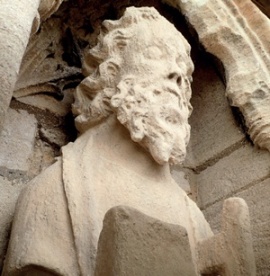 |
||
| Conserved figure at Crowland Abbey church, Lincolnshire by Alex Carrington using hot-mixed mortars and sheltercoats |
Running quicklime to putty became more common for plastering and building during the 20th century because it was a quick and easy way of slaking large volumes of lime. However, it was used in the knowledge that the resulting mortars would be gauged with gypsum or ordinary Portland cement, which were assumed to counter the inherent weakness of mortars made with this material while speeding the initial set but not the carbonation of the lime. It was a response to the demand for mass housing and increasing time pressures in the construction industry.
The idea of laying lime putty (albeit differently made) down for a minimum of three months is indicated by Alberti (1460), but he is unique in this prescription, which appears in his chapter on ornament. Millar (1897) indicates that plasters should be hot mixed and the resulting coarse stuff laid down to allow for late slaking for up to three months, although two weeks seems to have been the norm for both coarse stuff and, for fine finishes, lime putty. During the 19th century, lime was also sometimes run to putty for convenience, but with the expectation of gauging with natural cement. The following mid-19th-century account, for example, describes the preparation of mortars at Fort Warren (Boston Harbour) mixed by mortar mill and lime slaked by being thrown into a surplus of water:
The lime, thus deluged with water, loses probably some portion of its binding qualities, but the mortar at Fort Warren almost always contains hydraulic cement; and as this substance sets rapidly, it is highly essential that the lime should be thoroughly slaked before the admixture of the ingredients... the lime is reduced to [a] milky consistence, and allowed to remain in the vat as long as possible. It should be remembered, that the above method applies only when cement is added to the lime. When no cement is used, the lime must be slaked in the ordinary way, as the drenching of the lime would greatly impair its binding properties. (Wright 1845)
Limewashes too were made by adding just enough water to lump quicklime for it to slake. More water was then added and stirred in to achieve the desired consistency, typically thick enough that a dipped brush does not drip. The limewash was used immediately, first run through a sieve or otherwise, depending upon the situation, while still hot, for maximum effect.
Slaking itself takes a matter of minutes but significant heat remains for longer – sometimes for days if the mortar volume is large. Great store was placed on maximising the temperature of the slake in this and other mortar-making methods, whereas drowning the lime minimises the potential temperature. Quicklime slaked with too little water may reach 300°C before the addition of more water, which will bring the temperatures down below 100°C, typically to around 70°C in limewashes and to around 55°C in mortars. With precise water addition, the slaking temperature will be around 100°C. Too little risks ‘chilling’ the lime, reducing the effective binder content.
In modern, scientifically controlled hydrated air lime production, it is demanded that quicklime slakes at temperatures of 85-98°C to achieve the optimum surface area and porosity of the dry hydrate. Historically, significantly higher temperatures were generated. Van Der Kloes (1914) is unique in spelling out the perceived importance of maximising the temperature of the slake (others presumably took it as read). These temperatures sound alarming, but are easily managed and are, in truth, no more than those encountered in the average domestic kitchen. A minimum of 100°C is required; significantly greater temperatures than this will indicate insufficient water to effect the slake.
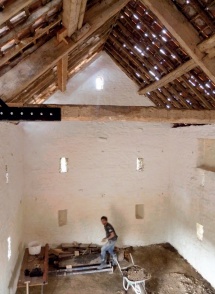 |
|
| Hot lime washing in a threshing barn at Thornton Dale (Photo: Sam Baxter) |
In our own practice, we have made limewashes by this method, as well as by incrementally feeding powdered quicklime into small volumes of water to produce a paste the consistency of ‘extra thick’ double cream, which, upon cooling overnight would appear as a putty lime. Stiffening only occurs upon cooling – used hot, the liquid flows. (Historically, grouts were always used hot to take advantage of this.) As a result, a hot limewash may be applied in thicker coats without crazing, effectively becoming putty on the wall.
In historic specifications, two or three coats of lime white (as limewash was called during the 19th century) is indicated. No ‘seven water-thin coats’ specified here – nor, indeed, are they likely to be found on historic surfaces, where limewashes can easily be confused for fine finish coats.
In our experience (gained through using quicklimes over the past ten years, both for hot-mixed mortars for all uses and for limewashes), limewashes and sheltercoats are best mixed directly from quicklime, made thicker than modern convention, and applied while still hot. This results in a strong and immediate bond to masonry and other substrates, and even 24 hours later they would be very difficult to remove.
The intimacy of the bond between lime, water and aggregates as a result of hot mixing is particularly well-demonstrated in the case of sheltercoats. Even coarse aggregates will be held in suspension in the liquid. If left for some days, these aggregates will sink to the bottom, but stirred they will once more remain in suspension for as long as required. Compare this to modern sheltercoats; mixed cold from matured lime putty, the aggregates compact at the bottom of the bucket, requiring a hammer and chisel to remove them. Application is often a race against time.
It has been a maxim of the lime revival (Schofield) to use hot water in the dilution of putty lime for limewashes, the better to engage any pigments. However, when mixing directly from quicklime, the heat comes free. Furthermore, the addition of the aggregates and pigments before or (when using powdered quicklime) during slaking locks all of the ingredients together more effectively than cold mixing.
Hot water was used to slake some hydraulic quicklimes in the past, accelerating an otherwise slow process, especially when hydraulic quicklime had been previously pulverised. Likewise, added fats or oils will be melted and properly engaged with the other ingredients in a way that simply does not occur when the limewashes are mixed cold, something that has led to the spectacular failure of such treatments in recent years.
Hot limewashes and sheltercoats dry out less readily than cold-mixed varieties, carbonate efficiently and give very good coverage. They are cost-effective and have proved appropriately durable. The north elevation of York House in Malton was given a Hamstone dust, fine sand, copperas and quicklime sheltercoat in 2007. This continues to require no replenishment.
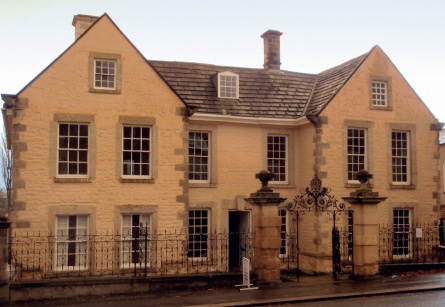 |
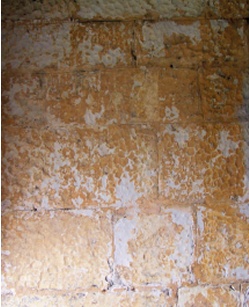 |
|||
| Above left: York House, Malton: a hot-mixed and applied sheltercoat with copperas pigment; above right: earlier copperas pigmented wash to York House | ||||
It should be said, however, that many of the beneficial properties of hot limewashes and sheltercoats endure when they have cooled – there are advantages in hot use, but good bond and good coverage remain available after cooling. As with hot-mixed mortars, it is the process of hot mixing that delivers an enhanced general performance with a strong bond between lime, aggregates and water – the method of slaking is key. Similarly, limewashes slaked in the traditional way were not always used hot, but our experience has been that hot use offers genuine advantages. Whether used hot or cold, the evidence would seem to be that they were generally used freshly made and applied much thicker than recently. Historically, two coats were usually specified.
ADDITIVES
There are several traditional formulae consisting of lime (not whiting) thoroughly slaked and thinned to a cream after slaking to which various additions are made, such as salt, alum, powdered glue, oils and fats and casein (skimmed milk), and a selection of formulae is shown in the table opposite. The effect of salt is probably to hold the moisture and facilitate the carbonation of the lime, while the addition of a small quantity of alum improves the working qualities and is thought to increase the hardness of the surface. Caseins and glues give greater binding properties to the mix.
Although done with cold putty limes, NPA research (Jackson 2005) demonstrated that the most efficient and durable limewashes were those composed of lime and water (with pigments as desired), and not those containing tallow or molasses or linseed oil. It was concluded that most additions were to help with the adherence of the material to the substrates, not durability.
While the addition of salt to limewashes may seem counter-intuitive, there is clear evidence that it improves the bond with the substrate.
In 2014, even a hot limewash struggled to uniformly attach to the repaired and previously abused timbers of the Jesuit Mission Church in Fort McMurray, Alberta, Canada, but the addition of common house salt (which was often specified in limewashes coloured with copperas/ferrous sulphate without salt addition) effected good attachment to the timbers.
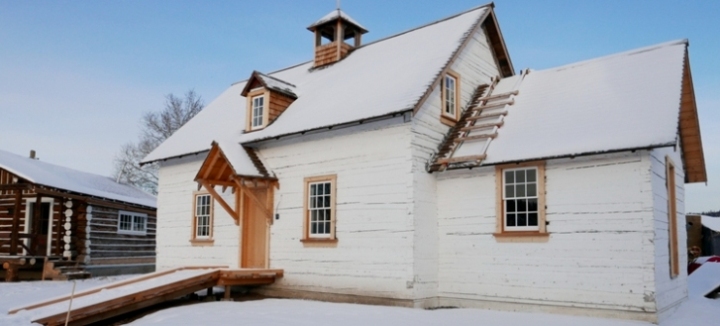 |
|
| Hot limewash with salt on the timber walls of the French Jesuit Mission Church (1910) at Fort McMurray, Alberta (Photo: Ben Gourley, MacDonald and Lawrence Timber Framers) |
The addition of house salt to limewashes for masonry structures remains common in many countries but is usually unnecessary, and in the UK’s damp climate the risk of salt migration into the fabric may outweigh any benefits.
Common limewash pigments include copperas (ferrous sulphate) and various natural earth pigments (iron oxides) such as ochre. Copperas was a by-product of the alum industry of North Yorkshire, and in London and Yorkshire it was not uncommon for an alum-copperas wash to be applied to masonry as a thin coating in the 19th century.
All of the above indicates that craftspeople in the past – when exterior limewashing with or without additives was routine – understood far more than we do today. To give them and the buildings they created due respect and recognition, we should use the materials they used, manipulated and applied in the same way. Not only will this offer compatibility and something more truly ‘like-for-like’, but it will make the lives of masons, plasterers and conservators easier and less frequently frustrating.
A CHEAP WASH For the outside of wooden cottages, barns, out-buildings, fences, etc, where economy must be consulted, the following wash is recommended: take a clean barrel that will hold water. Put into it half a bushel of quicklime, and slake it by pouring over it boiling water sufficient to cover it four or five inches deep, and stirring it until slaked. When quite slaked dissolve it in water, and add 2lbs of sulphate of zinc and one of common salt, which may be had at any of the druggists, and which in a few days will cause the whitewash to harden on the woodwork. Add sufficient water to bring it to the consistency of thick whitewash. To make the above wash of a pleasant cream color, add 3lbs of yellow ochre. For fawn color, add 4lbs of umber, 1lb of Indian red, and 1lb of lampblack; for gray or stone color, add 4lbs of raw umber and 2lbs of lampblack. The color may be put on with a common whitewash brush, and will be found much more durable than common whitewash. Jacques (1860) A TALLOW WASH The basis of most lime wash recipes is the mixing of a quantity of tallow, which may be from 2 to 10lbs, into a bushel of quicklime to form an insoluble calcium soap. The tallow should be placed in the centre of the quicklime and the whole should be slaked together. If the quicklime is slow in slaking [suggesting moderately hydraulic], it should be covered with sacking, and hot water should be used. The addition of pigment may necessitate an increase in tallow, but a useful mean to remember is 5lbs tallow to a bushel of quicklime. C Williams-Ellis (1919) WG SCOTT RECIPES The following recipes are taken from WG Scott’s ‘White paints and painting materials’ (Modern Painter, Chicago, 1910) and are reliable: ‘Factory’ whitewash for walls, ceilings, posts, etc (interiors) Weatherproof whitewash for buildings, fences, etc (exteriors) Lighthouse whitewash Note – Alum added to a lime whitewash prevents it rubbing off. An ounce to the gallon is sufficient. |
Historic sources reveal a wide variety of hot-mixed limewash recipes
~~~
References and Further Information
V Brito and T Diaz Gonçalves, ‘Artisanal lime coatings and their influence on moisture transport during drying’, 3rd Historic Mortars Conference, Glasgow, 2013
N Copsey, Hot Mixed Lime Mortars: General Specifications, 2016
E Hansen et al, ‘Effects of ageing on lime putty’, Proceedings of the International Rilem Workshop on Historic Mortars, Rilem Publications, France, 2000
M Hassibi, ‘An overview of lime slaking and factors that affect the process’, Chemco Systems LP, 2015
S Jackson, Study on the Durability of Traditional and Modified Limewash Recipes, National Park Service, US Dept of the Interior, 2005
P Nicholson, The New Practical Builder and Workman’s Companion, Thomas Kelly, London, 1823
W Millar, Plastering, Plain & Decorative, 1st edition 1897, reprinted Donhead, Shaftesbury, 1998
CW Pasley, Practical Architecture, 1826, reprinted Donhead, Shaftesbury, 2001
AC Smeaton, The Builder’s Pocket Manual, M Taylor, London, 1840
JA Van der Kloes, A Manual for Masons, Bricklayers, Concrete Workers and Plasterers, revised and adapted by Alfred B Searle, Churchill, London, 1914
David Wiggins, ‘Lime mortar and sacrificial weathering – how it works’, presentation to Hot-Mixed Mortars Forum, Coventry Cathedral, October 2016
C Williams-Ellis, Building in Cob, Pisé and Stabilized Earth, 1919, reprinted Donhead, Shaftesbury, 1999
WH Wright, A Brief Practical Treatise on Mortars, Thurston, Torry & Co, Boston, 1845



